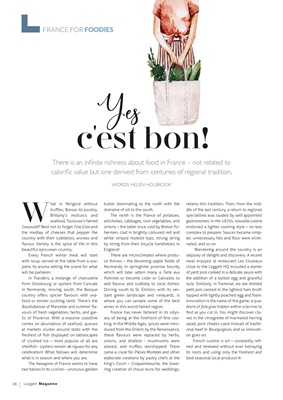
28W
hat is Perigord without
truffl es, Bresse its poultry,
Brittany's molluscs and
seafood, Toulouse's famed
Cassoulet? Best not to forget Foie Gras and
the medley of cheeses that pepper the
country with their subtleties, aromas and
fl avour. Variety is the spice of life in this
beautiful epicurean country.
Every French winter meal will start
with soup, served at the table from a soupière,
its aroma setting the scene for what
will be partaken.
In Flanders, a melange of charcuterie
from Strasbourg or oysters from Cancale
in Normandy, moving south, the Basque
country off ers spicier fl avours with seafood
or tender suckling lamb. There's the
Bouillabaisse of Marseille and summer fl avours
of fresh vegetables, herbs, and garlic of
Provence. With a massive coastline
comes an abundance of seafood, queues
at markets cluster around stalls with the
freshest of fi sh displayed on tablescapes
of crushed ice - most popular of all are
shellfi sh - oysters remain de rigueur for any
celebration! What follows will determine
what is in season and where you are.
The hexagone of France seems to have
two halves in its cuisine - unctuous golden
Leggett Magazine
butter dominating to the north with the
domaine of oil to the south.
The north is the France of potatoes,
artichokes, cabbages, root vegetables, and
onions - the latter once sold by Breton fi shermen, clad
in brightly coloured red and
white striped matelot tops, strung string
by string from their bicycle handlebars in
England!
There are microclimates where produce
thrives - the blooming apple fi elds of
Normandy in springtime promise bounty
which will later adorn many a Tarte aux
Pommes or become cider or Calvados to
add fl avour and subtlety to local dishes.
Driving south to St. Émilion, with its verdant green
landscape and vineyards, is
where you can sample some of the best
wines in this world-famed region.
France has never faltered in its odyssey
of being at the forefront of fi ne cooking.
In the Middle Ages, spices were introduced
from the Orient; by the Renaissance,
these fl avours were replaced by herbs,
onions, and shallots - mushrooms were
adored, and truffl es worshipped! There
came a craze for Pièces Montées and other
elaborate creations by pastry chefs at the
King's Court - Croquembouche, the towering creation
of choux buns for weddings,
There is an infi nite richness about food in France - not related to
calorifi c value but one derived from centuries of regional tradition.
retains this tradition. Then, from the middle of
the last century, a return to regional
specialities was lauded by self-appointed
gastronomes; in the 1970s, nouvelle cuisine
endorsed a lighter cooking style - no less
complex to prepare. Sauces became simpler,
unnecessary fats and fl our were eliminated, and so on.
Wandering around the country is an
odyssey of delight and discovery. A recent
meal enjoyed at restaurant Les Cluzeaux
close to the Leggett HQ included a starter
of petit pois cooked in a delicate sauce with
the addition of a boiled egg and graceful
tuile. Similarly, in Tremolat, we ate shelled
petit pois cooked in the lightest ham broth
topped with lightly poached egg and foam.
Innovation is the name of the game; a quadrant
of foie gras hidden within a terrine to
fi nd as you cut in. You might discover cloves
in the vinaigrette of marinated herring
salad, pork cheeks used instead of traditional beef
in Bourguignon, and so innovation goes
on.
French cuisine is art - constantly refi ned and renewed
without ever betraying
its roots and using only the freshest and
best seasonal local produce!
c'est bon!Yesc'est bon!
WORDS: HELEN HOLBROOK
FRANCE FOR FOODIES